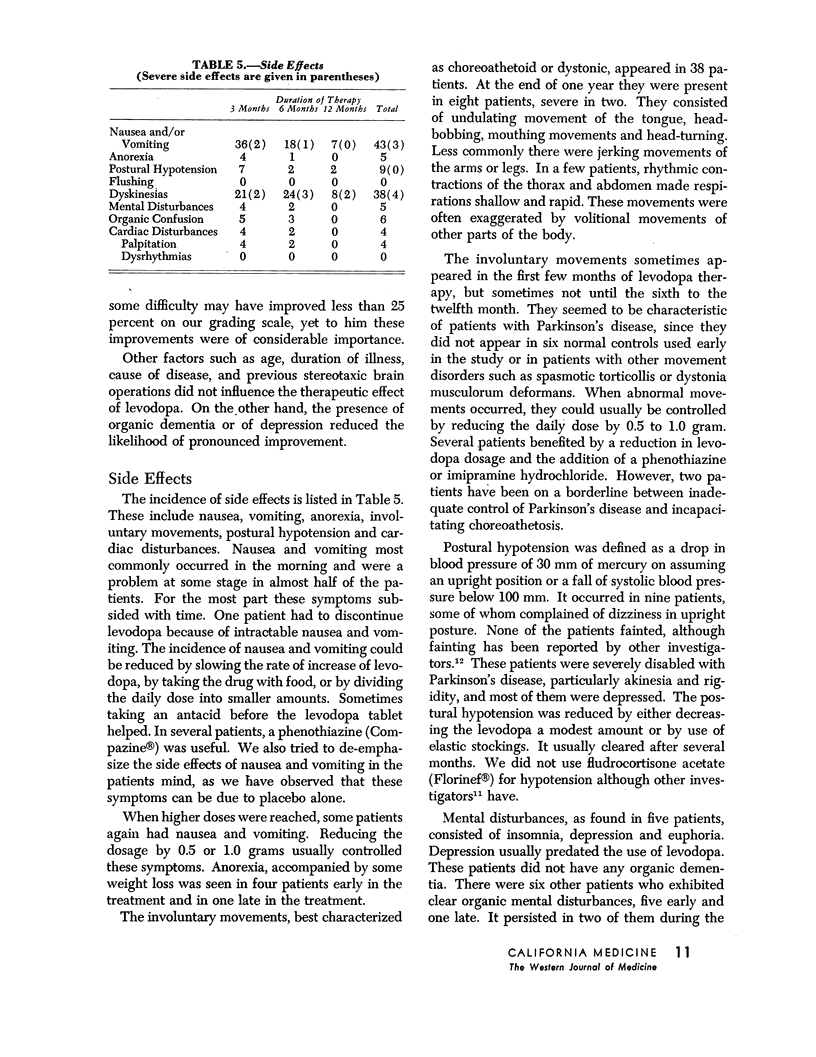Abstract
One hundred patients with Parkinson's disease were treated with levodopa for more than a year at UCLA Medical Center. They were examined at given intervals and their improvement was graded. The optimum therapeutic dose was attained by balancing side effects against relief of symptoms and ranged from 1.5 grams to 8.0 grams per day (average 4.3 grams). There is no doubt that levodopa is the most effective treatment now available for Parkinson's disease. At the end of the first year, 60 percent of the patients improved 50 percent or better, and 10 percent were considered symptom-free. All major symptoms of this disease, including rigidity, akinesia and tremor, improved in variable degree.
There were no serious abnormalities in the routine clinical laboratory tests. The comon side effects included nausea, vomiting and choreoathetoid dyskinesias. The side effects were not life threatening, but occasionally were major therapeutic challenges.
Maximal benefits with minimal side effects were achieved only by careful adjustments of the levodopa dosage as the months went by. This needed careful management by the physician and cooperation by the patient. Anticholinergic medications or amantadine hydrochloride, sometimes both, usually supplemented the effect of the levodopa.
Full text
PDF







Selected References
These references are in PubMed. This may not be the complete list of references from this article.
- BARBEAU A., MURPHY G. F., SOURKES T. L. Excretion of dopamine in diseases of basal ganglia. Science. 1961 May 26;133(3465):1706–1707. doi: 10.1126/science.133.3465.1706-a. [DOI] [PubMed] [Google Scholar]
- BERTLER A., FALCK B., ROSENGREN E. THE DIRECT DEMONSTRATION OF A BARRIER MECHANISM IN THE BRAIN CAPILLARIES. Acta Pharmacol Toxicol (Copenh) 1963;20:317–321. doi: 10.1111/j.1600-0773.1964.tb01752.x. [DOI] [PubMed] [Google Scholar]
- BERTLER A., ROSENGREN E. Occurrence and distribution of dopamine in brain and other tissues. Experientia. 1959 Jan 15;15(1):10–11. doi: 10.1007/BF02157069. [DOI] [PubMed] [Google Scholar]
- BIRKMAYER W., HORNYKIEWICZ O. [The L-3,4-dioxyphenylalanine (DOPA)-effect in Parkinson-akinesia]. Wien Klin Wochenschr. 1961 Nov 10;73:787–788. [PubMed] [Google Scholar]
- CARLSSON A. The occurrence, distribution and physiological role of catecholamines in the nervous system. Pharmacol Rev. 1959 Jun;11(2 Pt 2):490–493. [PubMed] [Google Scholar]
- Cotzias G. C., Papavasiliou P. S., Gellene R. Modification of Parkinsonism--chronic treatment with L-dopa. N Engl J Med. 1969 Feb 13;280(7):337–345. doi: 10.1056/NEJM196902132800701. [DOI] [PubMed] [Google Scholar]
- Cotzias G. C., Van Woert M. H., Schiffer L. M. Aromatic amino acids and modification of parkinsonism. N Engl J Med. 1967 Feb 16;276(7):374–379. doi: 10.1056/NEJM196702162760703. [DOI] [PubMed] [Google Scholar]
- MONTAGU K. A. Catechol compounds in rat tissues and in brains of different animals. Nature. 1957 Aug 3;180(4579):244–245. doi: 10.1038/180244a0. [DOI] [PubMed] [Google Scholar]
- McDowell F., Lee J. E., Swift T., Sweet R. D., Ogsbury J. S., Kessler J. T. Treatment of Parkinson's syndrome with L dihydroxyphenylalanine (levodopa). Ann Intern Med. 1970 Jan;72(1):29–35. doi: 10.7326/0003-4819-72-1-29. [DOI] [PubMed] [Google Scholar]
- Wurtman R. J., Rose, Matthysse S., Stephenson J., Baldessarini R. L-dihydroxyphenylalanine: effect on S-adenosylmethionine in brain. Science. 1970 Jul 24;169(3943):395–397. doi: 10.1126/science.169.3943.395. [DOI] [PubMed] [Google Scholar]
- Yahr M. D., Duvoisin R. C., Hoehn M. M., Schear M. J., Barrett R. E. L-Dopa (L-3,4-dihydroxyphenylanine)--its clinical effects in parkinsonism. Trans Am Neurol Assoc. 1968;93:56–63. [PubMed] [Google Scholar]
- van Woert M. H., Bowers M. B., Jr Homovanillic acid (HVA) and 5-hydroxyindoleacetic acid (5HIAA) during L-dopa therapy of Parkinson's disease. Neurology. 1970 Apr;20(4):377–377. [PubMed] [Google Scholar]


